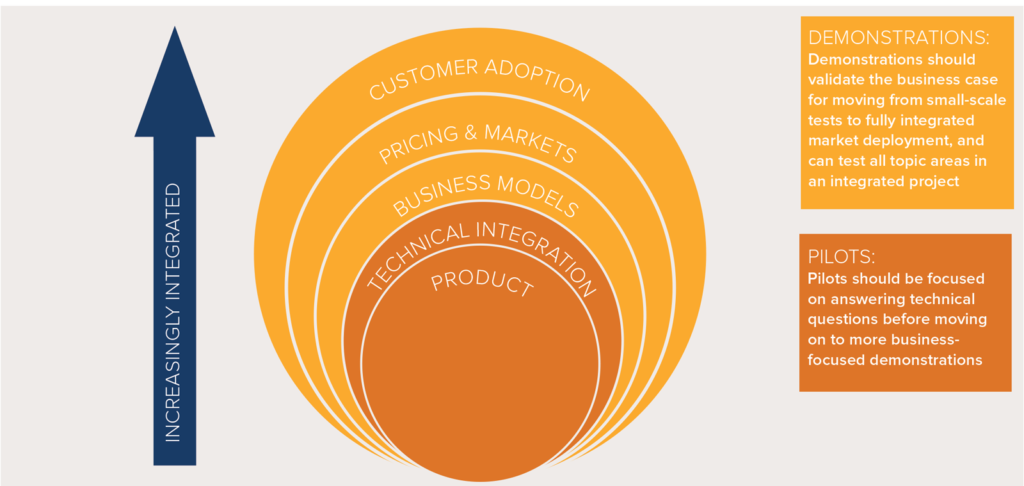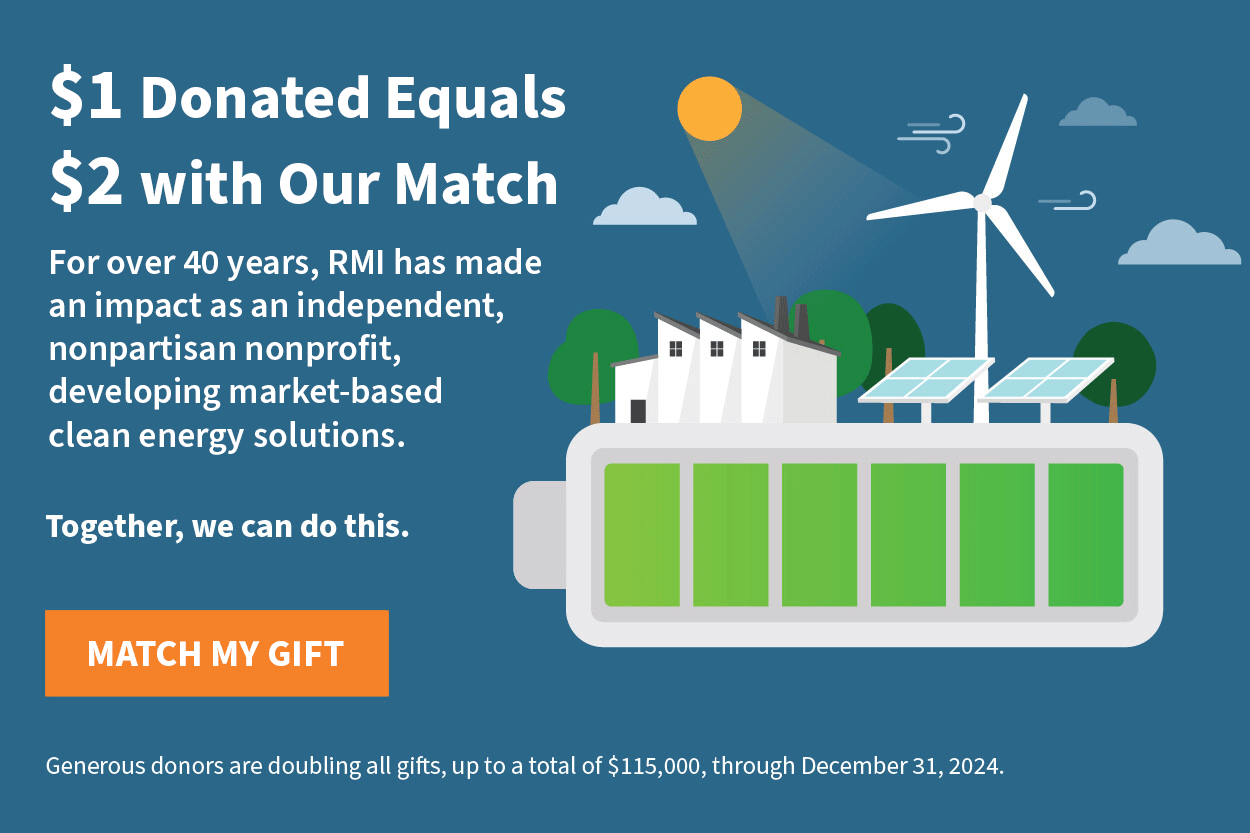
Pathways for Innovation
The Role of Pilots and Demonstrations in Reinventing the Utility Business Model
Download RMI’s New Report, Pathways for Innovation: The Role of Pilots and Demonstrations in Reinventing the Utility Business Model
The rapid growth of distributed energy resources (DERs) and large-scale renewable energy is driving utilities to test and develop a variety of new technologies, business models, and customer-facing programs. DERs are starting to impact the U.S. electric power system at a significant scale—a record 2.5 GW of residential solar installation and 159,000 electric vehicles were sold in 2016, up 19 percent and 37 percent, respectively, from 2015, for example. Energy efficiency programs are lowering energy use at homes and businesses to the extent that most areas of the U.S. are no longer seeing growth in their electricity demand.
The proliferation of these technologies poses new challenges for utilities. As energy efficiency and self-generation erode electricity demand, utilities must balance how to fund necessary investments in the grid alongside declining sales volumes. The proliferation of third-party energy devices on the grid creates new uncertainty for utilities in grid operation, as parts of the grid no longer fall under a traditional model in which the utility controls all grid assets. Today, utilities must develop new capabilities to integrate these technologies and manage new two-way flows of energy on local distribution grids. Making the transition to a DER-rich future requires piloting new approaches to operating the electricity system, to engaging customers, to working with third-party DER providers, and to the utility business model itself.
Rocky Mountain Institute partnered with three leading utilities—Arizona Public Service (APS), Avista Utilities, and Con Edison—to explore best practices for utility innovation and the design, execution, and evaluation of utility pilot and demonstration projects. We interviewed industry stakeholders representing regulatory bodies, utilities, technology providers, and advocates to gather broad input on what works well, what does not, and how to improve project results.
At its best, the U.S. electricity industry can test a variety of promising and innovative approaches to integrating new technology for the benefit of customers, utilities, and the environment. This can happen both efficiently, with little wasted effort and effective cross-industry learning, and collaboratively, with utilities and technology providers working together with aligned incentives to achieve shared outcomes.
At its worst, innovation can get bogged down by contentious disputes between utilities and technology providers, low-value pilots that produce little in the way of results, ineffective pilots hampered by organizational disconnects and poor design, and redundant programs that fail to build on results experienced elsewhere in the industry.
Figure 1: Pilots and demonstrations focus on different topic areas
In our new report, Pathways for Innovation: The Role of Pilots and Demonstrations in Reinventing the Utility Business Model, we provide recommendations for utilities, regulators, and DER providers, centered around five primary themes that emerged when we investigated the state of utility demonstration programs in the U.S.:
- Strategic planning: embrace a strategy for energy system transformation and craft a complementary road map for innovation. Utilities must recognize the imperative for change in their corporate strategies and develop innovation road maps that complement strategic goals. Regulators owe utilities clear and consistent messaging around their own strategic priorities for innovation. Successful DER providers will need to understand the varied utility business models and regulatory environments around the country in order to offer effective solutions.
- Designing to scale: design pilots and demonstrations to maximize learning and prepare for full-scale deployment. Create a distinction between exploratory pilots that only test technical feasibility and scalable demonstrations, and those that also test business models, customer adoption, and other elements necessary for scaling. When possible, utilities should conduct demonstrations that put all these pieces together. Regulators can help by creating the financial incentives for utilities to pursue innovative solutions for customers in a DER-rich energy system, as opposed to the typical incentive to increase capital spending to grow the rate base.
- Organization: create leadership support and accountability, dedicated resources, and cross-functional collaboration within the utility for effective innovation. To overcome silos and competing priorities, utilities should formalize responsibility for innovation within their organizations, with an accountable senior leader and formal role definitions for employees. Innovation teams must also engage business units across the utility in the design, execution, evaluation, and scaling of demonstration projects to design better projects and ensure the impact sticks.
- Stakeholder engagement: collaborate effectively across industry stakeholder groups to design and execute meaningful projects. Utilities, technology providers, regulators, customers, and advocates all must engage collaboratively on new concepts to build common ground and avoid contentious and unproductive disputes in the pursuit of cutting-edge demonstration projects. Regulators should express support for multistakeholder collaboration outside of formal proceedings. Utilities can also seek broad and creative solutions from vendors through solicitations structured around addressing system and customer needs and avoiding overly prescriptive requests for proposals that arbitrarily limit the solution space.
- Cross-utility collaboration: share best practices and lessons learned among utilities to accelerate effective innovation. The utility industry can segment itself into groups with similar motivations or challenges, synthesize the important learning and best practices among the broad array of information and reports, and share publicly their own lessons learned for the benefit of the industry. Regulators can ensure that utility pilots build on lessons from other states, where possible, and that utilities publicly share meaningful evaluations of their own pilots and demonstrations.
Creating an efficient, clean, resilient, and affordable electricity system will require increased adoption of leading technologies, new approaches to operating the energy system, and a significant shift in the nature of energy infrastructure investments. These all require transformative change and innovation in the utility industry and evolution of the utility business model. Meaningful pilots and demonstration projects that are designed well provide innovation pathways that utilities can follow as they seek to reinvent themselves. With this report, RMI explores these themes in depth and offers recommendations for utilities, regulators, and technology companies to incorporate meaningful pilot and demonstration projects into innovation programs that will bear new models for our future energy system.
Image courtesy of iStock.

